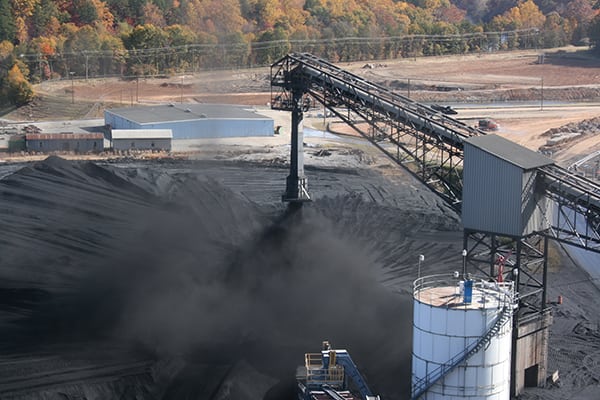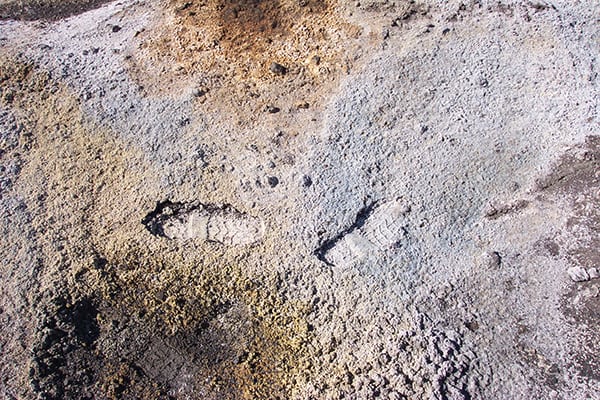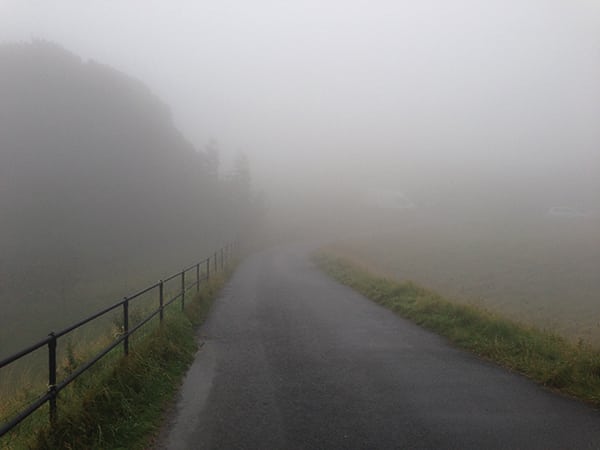"Who Moved My Btus?" The Pitfalls of Extended Coal Storage
Many coal power stations have recently been operating at historically low capacity factors or have even undergone extended economic shutdowns. This can result in coal stockpiles that are exposed to the elements for much longer times than anticipated, resulting in a loss of usable coal energy by several mechanisms. This article explores the severity of the problem and provides suggestions for preserving the energy that you paid for.
Death came for the boiler, black and shimmering in the afternoon heat. It was gathered in piles and dropped onto conveyors. It was fed to the great beasts of the coal mills, which growled and complained as they struggled to grind it. The boiler tried its best to meet demand but was starved for energy even as its insides were increasingly coated with atherosclerotic slag. A mill tripped and the boiler faltered. Then it gasped its last breath as the induced draft fan tripped.
The boiler was dead.
The postmortem was somber, but free of accusations and recriminations. Everyone knew the cause: Due to unprecedented rail line disruptions, the plant had been forced to reclaim coal from a section of its stockpile that had sat relatively undisturbed for more than two years. Just as we all reach for the milk carton with the longest expiry date at the grocery store, plant personnel had always taken the freshest coal for filling the coal silos. Although operations knew to expect some problems from the coal, no one was prepared for exactly how much the coal had degraded from its original delivered quality. A week later, at the postmortem, the lab results delivered a stunning message: Nearly 25% of the original heat content of the coal had vanished.
Several of the power stations I work with have faced similar challenges. Fierce competition from cheap natural gas, milder summers and winters, and environmental regulations have reduced coal burn rates at many sites, leading to greatly extended storage durations and a greater loss of total coal stockpile energy. This in turn has exacerbated operations and maintenance challenges at these power stations, potentially reducing the capacity factor even further, while increasing the total fuel-related cost of generation.
What Happened to My Coal?
Coal begins to lose energy almost the minute it’s mined, through a variety of means.
Upon exposure to the atmosphere, a slow oxidation process begins, essentially burning away heat content. Once the coal is handled—through loading, shipping, unloading, stockpiling, and reclaiming—it will lose energy from dust and fines at each step of the process. In addition, moisture is typically gained during shipping and storage, which results in a variety of negative impacts at the power station. While the coal lies in storage, the oxidation process will continue, accelerated by exposure to the elements, potentially leading to spontaneous combustion.
Although most coal power station personnel understand that these three mechanisms—loss of energy through oxidation, dust and fines, and added moisture—will affect their coal stockpiles, the magnitude of the degradation is often unknown. This article explores the root causes of each of these energy loss pathways, how they affect a power station, the magnitude of the degradation that can occur, and methods for reducing both coal mass and coal quality losses.
Dust in the Wind
Anyone who has worked in the coal industry knows that coal is a friable material, and each time it is handled there is potential for generating fines and dust. In some cases, a coal terminal, preparation plant, or power station can accumulate coal dust in piles deep enough to wade through. One coal preparation plant I visited maintained an on-site waste stockpile of more than 1 million tons of coal fines, piled in a giant berm and slowly smoldering from spontaneous combustion in the desert heat. Although it is a clear nuisance and safety hazard, we sometimes fail to consider the magnitude of the coal dust problem (Figure 1).
Significant amounts of coal can be lost via dusting during transport to the power station. A study along a 500-mile section of rail for the Norfolk Southern line found average losses ranging from 0.4 ton to 0.5 ton per car. When binding agents were sprayed onto the cars before delivery, these losses were reduced by 45%. Another study found that, under windy conditions, rail transport in uncovered cars can result in 1 to 2 tons of lost coal per car per trip. For bottom-dump rail cars, about 400 tons per year were lost through the gaps in the bottom doors. Dust losses during unloading of bottom-dump rail cars in Australia was measured at 0.0027% of the total annual coal received by power stations. For a 1 million ton per year site, that equates to 27 tons per year. In India, the Central Electricity Regulatory Commission employs a default assumption of coal losses from transportation and stockpiling of 0.2% for mine-mouth plants and 0.8% for other power stations. Actual power station data from India, however, reveals that annual transport and stockpile losses range from 1.8% to 6.6%.
There are many techniques for reducing coal dust losses. Coal should be received in as large a size as practical, thus reducing the surface area to volume ratio of coal in the stockpile. This may require operation of a coal yard crusher upon reclaim in order to provide properly sized coal to the plant.
Although bulldozers are necessary for proper compaction and handling operations, coal dust emissions from these operations can be significant. One study found that operating a bulldozer 12 hours a day for five days a week results in an annual loss of more than 32 tons of coal.
New coal plant designs should utilize longer conveyors and fewer transfer points to minimize coal losses during stockout and reclaim. One site designed its conveyors to incorporate a short horizontal section at the end of each run, minimizing the drop of coal onto the next transfer conveyor and greatly reducing coal dust and spillage. Skirting systems and vacuum dust collectors can also help recover lost coal.
One common method of reducing coal dust losses is wetting the coal, with plain water, chemical systems, or foam. However, adding moisture to coal can lead to the triple problems of clumping, self-heating (pyrophoricity), and heat content reduction. Spray water systems tend to add about 2% to 4% surface moisture to coal, whereas chemical spray systems add about 0.2% to 1.0% surface moisture, depending upon the chemical formulation. Foam systems typically add less than 0.2% moisture.
Water Retention Problems
Coal can gain water content at many points throughout the utilization process: during transport to the power station, while sitting at coal terminals, during cleaning processes, and while sitting in the stockpile. Even though all coal contains at least some moisture, minimizing moisture content is important for improving plant operations.
Every pound of water that enters your boiler will soak up more than 900 Btu in latent heat of vaporization, which for most boilers will never be efficiently recovered. Excess coal moisture can lead to handling problems and can greatly limit coal mills and other preparation systems. Additional coal moisture even reduces the efficiency of plant emissions control systems, by increasing both the coal burn rate and the flue gas mass flow rate.
Estimates of moisture gain during ocean or barge shipping vary greatly, with common assumptions being 1% to 2%. One Indian power station I worked with reported a consistent moisture content increase of 2% to 3% for Indonesian coal delivered, although the station was unable to differentiate between moisture gained while on the ocean and moisture gained while sitting at a coal terminal.
Even rail deliveries can gain moisture. One study conducted by Dynegy, which measured the quality of 24 train shipments of Powder River Basin (PRB) coal at the loadout in Wyoming and upon delivery at the power station, found on average there was a 100 Btu/lb loss of heat content and a moisture content increase of 0.75%.
Methods to reduce coal moisture gain are limited. Covered transport is a good first step (and it also reduces coal fines losses), but it can increase transportation costs. Reducing the time from the mine to stockpile is imperative for reducing moisture gain, so avoid having your coal spend long layovers at coal terminals. Covered storage at the power station is ideal, but it often incurs a very high capital cost and thus is uncommon. Opinions are divided over whether coal pile compaction helps prevent moisture gain, with most believing compacted piles are best overall.
Avoiding Unwanted Coal Combustion
Since the 1800s it has been known that coal can self-heat and spontaneously combust. Such a spontaneous fire is strongly suspected to have been the root cause of the sinking of the USS Maine in 1898, which helped to trigger the Spanish-American War. The source of self-heating is oxidation of the light hydrocarbons in the coal, a process that is exacerbated by both intrinsic and extrinsic factors:
■ Coal volatile matter content is strongly associated with self-heating, due to its indication of there being a greater amount of light hydrocarbons that can be liberated during handling and weathering. Coal oxygen content is also associated with increased self-heating potential, and it’s no coincidence that lower-rank coals, typically having higher volatile matter and oxygen content, are much more likely to suffer spontaneous combustion.
■ Coal pyrites (FeS2) can accelerate the oxidation process by two methods: They can act as a catalyst for the oxidation reaction of the coal, and when exposed to moist air, the pyrite itself can oxidize, providing additional heat to the coal pile (Figure 2).
■ Particle size of the coal has a strong influence, as smaller particles have a larger surface area per volume ratio and, thus, are more exposed to atmospheric oxygen.
■ Moisture can greatly influence coal self-heating under certain circumstances. Stockpiled coal typically has a surface moisture content that reaches equilibrium with the ambient humidity. When dry air flows over the coal, its surface moisture undergoes desorption, cooling the coal surface. But when moist air (or liquid water) flows over coal that has undergone desorption, the opposite effect occurs, called adsorption. This is an exothermic process that can add up to 45 Btu/lb for subbituminous coals. Although this doesn’t sound like much, in a large coal stockpile with tens of thousands of tons of coal, it can liberate a significant amount of heat, increasing the self-heating and oxidation of the coal.
■ Heat will increase the rate of coal stockpile oxidation, with the risk of spontaneous combustion greatly increasing in summer months and during days of full sun. Some suppliers of low-rank coal recommend cooling the pile with water sprays, provided that the pile is relatively fresh and has not already undergone desorption.
■ Exposure to atmospheric oxygen is one of the most critical factors controlling the oxidation of coal. Coal piles should be compacted regularly to reduce the amount of air trapped within them and to lessen air infiltration into the pile. Coal piles should also be maintained at a low profile to minimize the potential for a “chimney effect” occurring within the pile, concentrating heat and leading to spontaneous combustion. Recommendations for maximum coal pile heights vary greatly, with most recommending that stockpiles be no more than 24 to 40 feet high.
■ Wind exposure should be kept to a minimum, with covered storage being preferred. Covered storage should utilize heat and combustion sensors, as well as fire and dust suppression systems, to allow plant staff to prevent fires and explosions.
Pile rotation should be carefully tracked and managed to prevent self-heating coal from sitting for lengthy periods of time. This will have the coincident benefits of reducing moisture uptake (Figure 3) and excessive dusting from weathering decomposition.
Managing Coal Piles for Minimal Losses
Coal heat content losses can vary tremendously across different sites and types of coal. A study in the United Kingdom found that, with proper stockpile management, high-rank bituminous coal lost only 0.65% of its heat content over several years. Another study found a low-rank subbituminous coal can lose 1.5% of its heat content just between the mine and the power station. A study of low-rank coal in Brazil found stockpile heat content losses of 5.6% over just 10 months.
One study I was involved in examined the effect of oxidation losses to a 20,000-ton pile of high-volatile PRB coal that had sat for 29 months. The plant was astonished to discover that not only had the heat content decreased from its original 8,800 Btu/lb to an average of 7,800 Btu/lb, but the moisture content of the pile was actually less than the original delivered moisture content (25%, versus 27%). What was immediately apparent from the coal proximate and ultimate analyses was that the volatile matter and hydrogen content had decreased disproportionately, and the fixed carbon, elemental carbon, and oxygen content all increased disproportionately—clearly indicating oxidation losses.
A Spanish study at an Endesa power station examined different methods of preventing heat content losses from oxidation in five different coal stockpiles, using a coal that was notorious for undergoing dangerous self-heating. The control pile was a truncated pyramid with 45° sloped sides and no special protection. The second pile was compacted twice a week for the first 80 days, then once a week for the next 110 days. The third pile was made into a lower-profile pyramid with 25° slopes. The fourth pile used a wind screen of pine boards. The fifth pile was sealed with a slurry of fly ash and water, with 16.1 tons of fly ash spread over 2,045 tons of coal. The results of this study were astounding:
■ The control pile underwent powerful oxidation in its first 100 days, and its average internal temperature rose to more than 290F within 80 days. Thermocouples inserted into the pile detected hot spots of nearly 950F! After 270 days, this pile lost both 12.5% of its mass and 7.6% of its heat content.
■ The compacted pile also underwent a temperature rise, but much more slowly, and the temperature did not equal that of the control pile until after more than 210 days. After 270 days, this pile lost 7.1% of its weight and 4% of its heat content.
■ The low-angle sloped pile underwent an even slower temperature rise and only reached an average internal temperature of 220F in about 210 days. After 270 days, this pile lost 4.8% of its mass and 14.2% of its heat content.
■ The pile protected by a wind barrier performed even better, with its average internal temperature never exceeding 130F. During testing, the wind screen failed in a storm, and the pile temperature immediately began to rise, then decreased again after the screen was repaired. After a slightly shorter period of 250 days, this pile lost less than 1% of its mass and 4.8% of its heat content.
■ The pile protected by the ash slurry coating performed the best, experiencing the slowest temperature rise by far and an average internal temperature measured at less than 106F. The maximum internal temperature of the slurry-coated pile was only 191F. After 190 days this pile lost 1.6% of its mass but only 0.6% of its heat content.
When measuring the effectiveness of the different methods of pile protection, it was found that using the wind barrier was the most expensive method, due to the capital cost of constructing and repairing the barrier. Though the low-slope pile was very cheap to employ, it still lost a significant amount of its heat content, and required additional area in the coal yard. The operating costs of regular compaction and protection by a fly ash slurry were both comparable and in the middle of the pack, with the fly ash slurry barrier providing the best results overall.
Several studies have found that coal pile orientation can also be a significant factor in oxidation loss. Generally speaking, portions of the pile that receive the greatest sun and wind exposure undergo significantly greater oxidation rates than average. In cases where a power station may have more than one on-site coal stockpile, placing the less-reactive coal pile on the sunward or windward side of storage could help reduce the chance of spontaneous combustion.
Some studies have found that mixing a more-reactive coal with a less-reactive coal in a stockpile can reduce the chance of spontaneous combustion, provided that the two coals have a similar particle size distribution in the pile. Many researchers recommend routine monitoring of temperature throughout the coal pile, although this can be difficult to manage at some sites without a committed effort. Regular coal sampling and analysis of the heat content, proximate analysis, and ultimate analysis is useful for revealing changes in the oxidation rate of the coal and can also assist coal yard management in ensuring that no portion of the stockpile sits for an excessive period of time.
The Future of Coal Storage
If coal power stations are going to be increasingly subject to the whim of competing energy prices, economic uncertainty, and environmental restrictions, the future of coal storage may be a move toward much smaller stockpiles. When I started my career, it was common for power stations to manage 60- to 90-day piles, with some sites managing 120-day or larger piles. Over the last five years, I’ve witnessed a shrinking of coal stockpile sizes, with some sites moving toward 30-day or even 20-day piles. However, critical baseload power stations are likely to continue keeping significant coal stockpiles on-site, which means that a proper understanding of the causes and remedies for coal stockpile loss will be important for years to come. ■
—Una Nowling, PE ([email protected]) is an adjunct professor of mechanical engineering at the University of Missouri-Kansas City.


